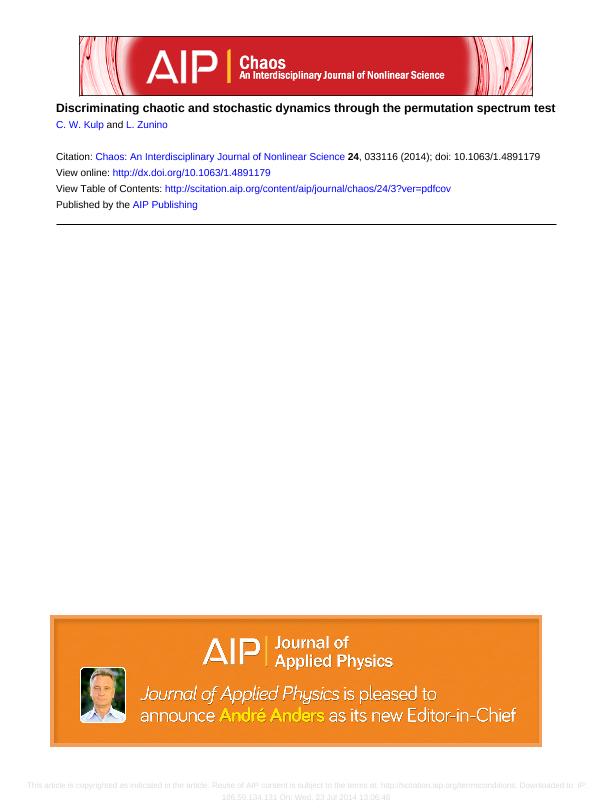Mostrar el registro sencillo del ítem
dc.contributor.author
Kulp, C. W.
dc.contributor.author
Zunino, Luciano José

dc.date.available
2017-01-24T19:36:29Z
dc.date.issued
2014-09
dc.identifier.citation
Kulp, C. W.; Zunino, Luciano José; Discriminating chaotic and stochastic dynamics through the permutation spectrum test; American Institute Of Physics; Chaos An Interdisciplinary Jr Of Nonlinear Science; 24; 3; 9-2014; 1-9; 033116
dc.identifier.issn
1054-1500
dc.identifier.uri
http://hdl.handle.net/11336/11847
dc.description.abstract
In this paper, we propose a new heuristic symbolic tool for unveiling chaotic and stochastic dynamics: the permutation spectrum test. Several numerical examples allow us to confirm the usefulness of the introduced methodology. Indeed, we show that it is robust in situations in which other techniques fail (intermittent chaos, hyperchaotic dynamics, stochastic linear and nonlinear correlated dynamics, and deterministic non-chaotic noise-driven dynamics). We illustrate the applicability and reliability of this pragmatic method by examining real complex time series from diverse scientific fields. Taking into account that the proposed test has the advantages of being conceptually simple and computationally fast, we think that it can be of practical utility as an alternative test for determinism.
The importance of distinguishing between periodic, chaotic, and stochastic dynamics from time series analysis is well-recognized for understanding the mechanisms that govern the regarded complex systems. In this work, we have introduced a conceptually simple and computationally fast symbolic visual test for discriminating chaotic and stochastic dynamics, called the permutation spectrum test. Because the symbolization is made by implementing the Bandt and Pompe methodology, all the advantages associated with this natural encoding (simplicity, extremely fast calculation, robustness, and invariance with respect to monotonous transformations) are inherited by the permutation spectrum test. We have shown that this pragmatic approach is robust in situations in which other tests fail. We have also confirmed its practical utility by examining several experimental and natural time series.
dc.format
application/pdf
dc.language.iso
eng
dc.publisher
American Institute Of Physics

dc.rights
info:eu-repo/semantics/openAccess
dc.rights.uri
https://creativecommons.org/licenses/by-nc-sa/2.5/ar/
dc.subject
Time Series Analysis
dc.subject
Chaotic Dynamics
dc.subject
Stochastic Dynamics
dc.subject
Permutation Spectrum Test
dc.subject.classification
Otras Ciencias Físicas

dc.subject.classification
Ciencias Físicas

dc.subject.classification
CIENCIAS NATURALES Y EXACTAS

dc.title
Discriminating chaotic and stochastic dynamics through the permutation spectrum test
dc.type
info:eu-repo/semantics/article
dc.type
info:ar-repo/semantics/artículo
dc.type
info:eu-repo/semantics/publishedVersion
dc.date.updated
2017-01-24T14:42:15Z
dc.identifier.eissn
1089-7682
dc.journal.volume
24
dc.journal.number
3
dc.journal.pagination
1-9; 033116
dc.journal.pais
Estados Unidos

dc.journal.ciudad
Maryland
dc.description.fil
Fil: Kulp, C. W.. Lycoming College; Estados Unidos
dc.description.fil
Fil: Zunino, Luciano José. Consejo Nacional de Investigaciones Científicas y Técnicas. Centro Científico Tecnológico La Plata. Centro de Investigaciones Opticas (i); Argentina. Provincia de Buenos Aires. Gobernación. Comisión de Investigaciones Científicas; Argentina. Universidad Nacional de La Plata. Facultad de Ingenieria; Argentina
dc.journal.title
Chaos An Interdisciplinary Jr Of Nonlinear Science

dc.relation.alternativeid
info:eu-repo/semantics/altIdentifier/doi/http://dx.doi.org/10.1063/1.4891179
dc.relation.alternativeid
info:eu-repo/semantics/altIdentifier/url/http://aip.scitation.org/doi/10.1063/1.4891179
Archivos asociados
